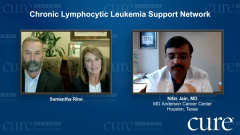
The Patient's Role in Deciding a Treatment
Episodes in this series

Nitin Jain, MD: We started Samantha on treatment with venetoclax with an antibody called rituximab. The reason we chose venetoclax for her was that it was a time-limited therapy for our patients. Venetoclax is typically combined with an antibody. There is an antibody called obinutuzumab, which is approved in the frontline setting, and there is also an antibody called rituximab, which is approved in the relapsed/refractory setting when you combine it with venetoclax. The reason we combine venetoclax with an antibody is because studies have shown that if you combine them, the chance of achieving a deep remission, called an MRD [minimal residual disease]-negative remission, is higher. Using venetoclax in combination with an antibody has become the new standard.
There are other therapies available for patients with CLL [chronic lymphocytic leukemia], including drugs such as ibrutinib and acalabrutinib. We still have a role for chemotherapy, such as FCR [fludarabine, cyclophosphamide and rituximab], which is a chemotherapy regimen, for a very select group of patients. The majority of patients today are receiving targeted therapy. Samantha, we discussed these therapies with you, specifically venetoclax, in addition to ibrutinib and acalabrutinib. Acalabrutinib was not available at that time, but ibrutinib was. What information led you to proceed with the venetoclax therapy?
Samantha Rine: The appealing aspect of the venetoclax treatment was it being about one year in length. You said venetoclax was either one or two years in duration, depending on how I responded, and I wouldn’t have to be on a drug for the rest of my life. You said there would be little to no side effects. As I had a minor blood clot in one of my lungs, there was a risk of the other therapy you mentioned not being a good fit. Therefore, being a new patient with a brand-new diagnosis and not knowing anything about leukemia, I deferred to your expertise.
Doug Rine: What I thought was interesting was that rituximab/venetoclax was not actually an approved first-line treatment at that time. However, understanding that you were working on the treatment personally, and seeing that it had such good results as a new treatment, was encouraging.
Nitin Jain, MD: Similar to Samantha, we have patients coming for new treatment with CLL, and there are many options available for them. We have venetoclax, which is what Samantha received, but we also have treatments with ibrutinib and acalabrutinib. Specifically, those treatments involve pills that are supposed to be taken for life. They work well and control the leukemia as long-term therapies. Pros for these long-term therapies include them being somewhat easier to get started with. Moreover, you don’t have to monitor the blood counts that often, and it doesn’t lower the blood counts often as well. Thus, there is an increased ease of getting started with the treatment, although these therapies are supposed to be taken long term.
I present both the options to the patients, lifelong therapy versus one-year therapy. Then I let them decide which therapy they want based on their lifestyle and how often they want to come to Houston to see us. If you are starting on venetoclax and if you are doing the infusions, you must come once a month. However, if you are on these other pills, it is fewer visits to the doctor early on. Now we have many options for our patients with CLL. We can choose for the patients and let them decide which option they want. Regarding side effects, the only thing you had Samantha was the neutropenia, the low blood counts?
Samantha Rine: Correct.
Nitin Jain, MD: That aside, a small number of patients complain of loose stools or skin rash. But you did not have those side effects, correct?
Samantha Rine: I did not have any of those side effects.
Nitin Jain, MD: That’s wonderful. Most patients do not know they’re receiving the treatment because they feel fine. And it’s only when they go to the doctor, and they check blood counts, will they say, “Oh, your neutrophil count is low, we need to hold the drug." However, you won’t feel any differently if you have a low neutrophil count because your body won’t tell you anything is wrong.
Comparing Samantha to other patients in the practice, it is very similar. Most of the time we deal with monitoring the blood counts, and calling the patients and letting them know what their blood counts are. But if you ask for symptoms, “are you having any side effects from the drug itself, like nausea, vomiting, or diarrhea,” those things are relatively few. Very few patients have those side effects.
Transcript Edited for Clarity














